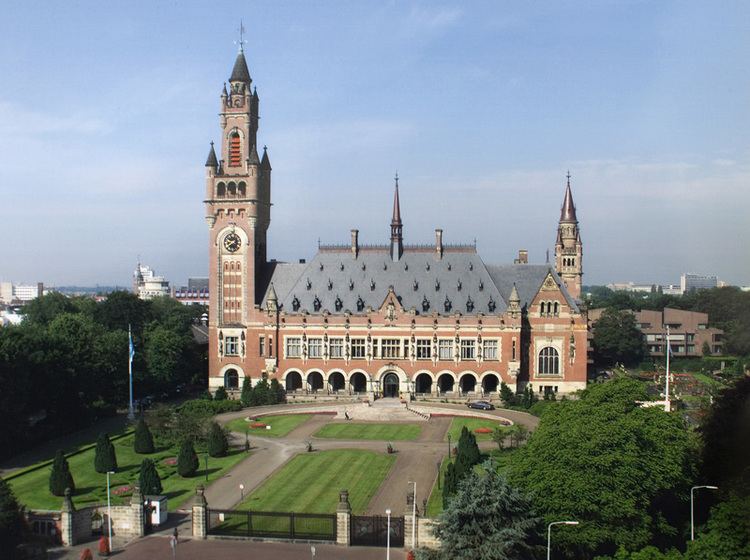Architectural style Neo-Renaissance Opened 28 August 1913 Architect Louis Marie Cordonnier | Groundbreaking 1907 Province South Holland | |
 | ||
Cost US$1.5 million ($40,000,000, adjusted for inflation) Address Carnegieplein 2, 2517 KJ Den Haag, Netherlands Hours Closed today SaturdayClosedSundayClosedMonday1–5PMTuesday10AM–5PMWednesday10AM–5PMThursday10AM–5PMFriday10AM–5PMSuggest an edit Similar Madurodam, Binnenhof, Ridderzaal, Mauritshuis, Panorama Mesdag Profiles | ||
Holland peace palace vredespaleis the hague hd
The Peace Palace (Dutch: Vredespaleis; [ˈvreːdəspaˌlɛis]) is an international law administrative building in The Hague, the Netherlands. It houses the International Court of Justice (which is the principal judicial body of the United Nations), the Permanent Court of Arbitration, the Hague Academy of International Law and the Peace Palace Library. The Palace officially opened on 28 August 1913, and was originally built to provide a home for the Permanent Court of Arbitration, a court created to end war by the Hague Convention of 1899. Andrew Dickson White, whose efforts were instrumental in creating the court, secured from his friend American steel magnate Andrew Carnegie US$1.5 million ($40,000,000, adjusted for inflation) to build the Peace Palace.
Contents
- Holland peace palace vredespaleis the hague hd
- Peace palace
- Occupants
- Conception
- Construction
- Grounds
- Art
- References
The European Heritage Label was awarded to the Peace Palace on 8 April 2014.
Peace palace
Occupants
The Peace Palace has been occupied at different times by a number of organisations:
Other international courts in The Hague, the Iran-United States Claims Tribunal, the International Criminal Tribunal for the former Yugoslavia and the International Criminal Court are separate organizations, located elsewhere in The Hague.
Conception
The idea of the Palace started from a discussion in 1900 between the Russian diplomat Friedrich Martens and American diplomat White over providing a home for the Permanent Court of Arbitration (PCA). White contacted Andrew Carnegie. Carnegie had his reservations, and at first was only interested in donating money for the establishment of a library of international law. White, however, was able to convince Carnegie, and in 1903 Carnegie agreed to donate the US$1.5 million ($40,000,000, adjusted for inflation) needed to house the court as well as to endow it with a library of international law. White described his idea to Carnegie:
"A temple of peace where the doors are open, in contrast to the Janus-temple, in times of peace and closed in cases of war (…..) as a worthy testimony of the people that, after many long centuries finally a court that has thrown open its doors for the peaceful settlement of differences between peoples".
Were such a fabric to be created, men would make pilgrimages from all parts of the civilized world to see it. It would become a sort of holy place, prized and revered by thinking men throughout the world, and to which, in any danger of war between any two countries, the minds of men would turn naturally and normally. The main difficulty now is that the people of the various nations do not really know what was done for them by the Conference; but such a building would make them know it. It would be an "outward and visible sign" of the Court, which would make its actual, tangible existence known to the ends of the earth"
—Andrew Dickson White to Andrew Carnegie, 5 August 1902At first Carnegie simply wanted to donate the money directly to the Dutch Queen Wilhelmina of the Netherlands for the building of the palace, but legal problems prohibited this, and in November 1903 the Carnegie Stichting was founded to manage the construction, ownership, and maintenance of the Palace. This foundation is still responsible for these issues.
Construction
To find a suitable design, the foundation called for an open international competition. The winning design, set in the Neo-Renaissance style, was submitted by French architect Louis M. Cordonnier. To build within budget, Cordonnier and his Dutch associate Van der Steur adjusted the design. The palace initially had two big bell towers in front and two small ones in the back. Only one big tower and one small tower remained in the final building. Also to save money, the separate library building from the winning design was incorporated into the Palace itself.
The Palace is filled with many gifts of the different nations who attended the Second Hague Conference as a sign of their support. Among the gifts are a 3.2-tonne (3.1-long-ton; 3.5-short-ton) vase from Russia, doors from Belgium, marble from Italy, a fountain from Denmark, wall carpets from Japan, the clock for the clock tower from Switzerland, Persian rugs from Iran and wood from Indonesia and the United States of America.
In 1907 the first stone was symbolically placed during the Second Hague Conference. The construction began some months later and was completed with an inauguration ceremony on 28 August 1913, attended by Andrew Carnegie, among others.
In 2007, Queen Beatrix opened the new building for the Peace Palace Library of International Law, housing the entire catalogue of the library, a lecture hall and a new reading room in the bridge to the main building of the Peace Palace. Like the new Academy Hall, the library was designed by architects Michael Wilford and Manuel Schupp. A Visitors Centre was added to the Peace Palace in 2012, which is also designed by Michael Wilford.
Grounds
In 1908, Thomas Hayton Mawson won a competition to design the grounds. Because of budget constraints, he also had to discard design elements: mountains and sculptures. He made use of a natural watercourse on the site.
In 1999 an eternal peace flame was installed in front of its gates.
Art
The palace also features a number of statues, busts and portraits of prominent peace campaigners from around the world and of all eras.
